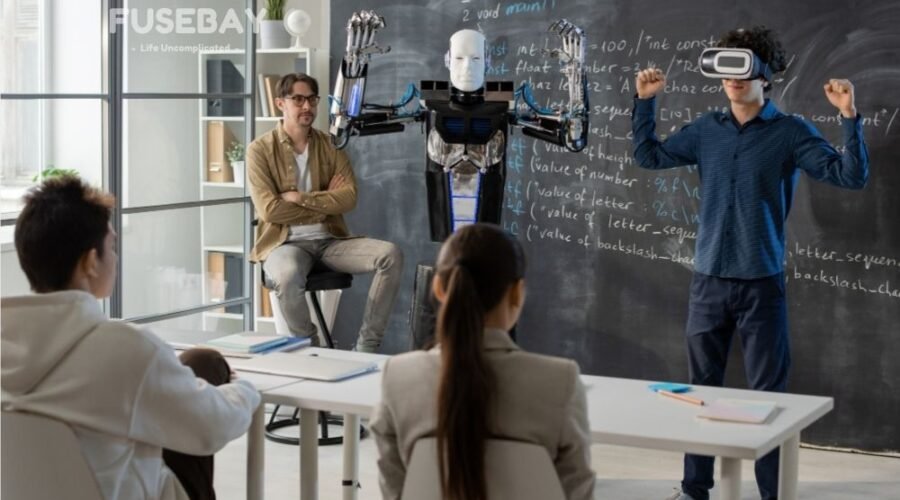The Importance of Artificial Intelligence in Teaching and Learning
Artificial Intelligence in Teaching and Learning: Artificial intelligence in teaching and learning is transforming the education sector by making it more personalized, efficient, and accessible. AI-powered tools assist teachers in reducing their workload, enabling them to focus on student engagement and critical thinking. From AI tutors to automated grading systems, the technology enhances learning experiences through tailored instruction. It also helps students grasp complex concepts through interactive simulations and virtual assistants. The growing implementation of AI in classrooms ensures better accessibility for learners with disabilities. Moreover, AI-driven insights allow educators to track student progress and adapt teaching methods accordingly. Importance of Artificial Intelligence in Education Artificial intelligence has become a game-changer in the education industry, addressing various challenges that traditional learning systems face. The importance of AI in teaching and learning is evident in the following ways: Applications of Artificial Intelligence: 1. Intelligent Tutoring Systems Intelligent Tutoring Systems (ITS) are AI-driven platforms that provide one-on-one tutoring to students. These systems simulate human tutors by offering explanations, answering questions, and guiding students through complex topics. 2. AI-Powered Content Creation AI is also transforming how educational content is created and delivered. AI tools can generate quizzes, lesson plans, and even entire textbooks tailored to specific curricula. 3. Language Learning and Translation AI-powered language learning apps and translation tools are breaking down language barriers in education. These tools enable students to learn new languages and access educational content in their native languages. The Role of AI in Personalized Learning: 1. Adaptive Learning Platforms AI-driven adaptive learning platforms analyze students’ learning patterns and adjust content accordingly. These platforms track student progress and provide tailored lessons to enhance comprehension. 2. AI-Powered Tutors Virtual tutors, powered by artificial intelligence, offer one-on-one assistance to students. These AI tutors assess students’ knowledge levels and provide real-time explanations and practice exercises. 3. Smart Content Creation AI assists in generating personalized study materials, including summaries, quizzes, and flashcards. This helps students focus on key topics and retain information effectively. AI in Automating Administrative Tasks: 1. Automated Grading Systems AI eliminates the need for manual grading by assessing multiple-choice tests, essays, and assignments. This reduces teachers’ workload and ensures unbiased evaluation. 2. Attendance Monitoring AI-driven facial recognition systems help track student attendance, eliminating manual roll calls and ensuring accuracy. 3. Scheduling and Planning AI-powered scheduling tools optimize lesson plans, exams, and assignments based on students’ and teachers’ availability. Enhancing Student Engagement with AI: 1. Gamification in Education AI-driven gamification techniques make learning fun and interactive. Educational games and simulations encourage students to participate actively. 2. Virtual and Augmented Reality AI integrates VR and AR into learning, enabling students to explore historical events, conduct virtual science experiments, and practice skills in realistic environments. 3. AI-Powered Chatbots Chatbots answer students’ questions instantly, offering explanations, study resources, and guidance anytime. AI for Bridging Learning Gaps: 1. Predictive Analytics in Education AI analyzes students’ performance data to predict learning difficulties. Teachers can intervene early to provide additional support. 2. Language Processing for Multilingual Support AI-powered translation and speech recognition tools help non-native speakers understand lessons in their preferred language. The Impact of AI on Teachers’ Roles: 1. AI as a Teaching Assistant AI supports teachers by managing repetitive tasks, allowing them to focus on mentoring and student interaction. 2. Enhancing Teaching Strategies AI-driven analytics help educators identify effective teaching methods, improving lesson delivery. 3. Encouraging Creativity and Critical Thinking With AI handling routine tasks, teachers can promote problem-solving skills and creativity among students. The Future of Artificial Intelligence: The future of artificial intelligence in teaching and learning looks promising, with continuous advancements in AI technology. AI will further enhance adaptive learning, making education more personalized and efficient. The integration of AI with emerging technologies like blockchain and IoT will improve data security and educational accessibility. AI-driven virtual classrooms will offer interactive experiences, ensuring quality education worldwide. As AI continues to evolve, educators and policymakers must work together to harness its potential responsibly. Conclusion Artificial intelligence in teaching and learning is revolutionizing the education sector by making learning more efficient, personalized, and accessible. AI-powered tools assist teachers, automate administrative tasks, and improve student engagement through interactive technologies. The benefits of AI include adaptive learning, automated grading, predictive analytics, and inclusive education. The future of artificial intelligence in teaching and learning holds great potential, ensuring quality education for all. As AI continues to advance, it will play a crucial role in shaping the future of education. Read More: Effective Steps to Build a Social Media Plan for Small Business FAQs (Frequently Asked Questions) 1. How is artificial intelligence used in teaching and learning? Artificial intelligence is used in teaching and learning through adaptive learning platforms, AI-powered tutors, automated grading systems, and virtual assistants. AI personalizes education by analyzing student performance and tailoring lessons accordingly. It also helps automate administrative tasks, allowing teachers to focus on student engagement. 2. What are the benefits of AI in education? AI enhances education by providing personalized learning, improving student engagement, automating administrative tasks, offering 24/7 support through chatbots, and making education more accessible for students with disabilities. It also helps teachers analyze student performance and refine teaching strategies. 3. Can AI replace teachers in the classroom? No, AI cannot replace teachers but rather acts as an assistant to enhance their teaching methods. While AI automates repetitive tasks and provides personalized support, human teachers are essential for mentoring, emotional intelligence, and fostering creativity and critical thinking in students. 4. What challenges does AI face in education? The main challenges include data privacy concerns, potential biases in AI algorithms, over-reliance on technology, and ensuring accessibility for all students. Educators and policymakers must ensure ethical AI implementation to avoid disparities in learning. 5. What is the future of AI in teaching and learning? The future of AI in education includes more advanced adaptive learning, AI-driven virtual classrooms, enhanced data security, and deeper integration with technologies like blockchain and IoT. As AI continues to evolve, it will play a significant role in making education more interactive, efficient,












